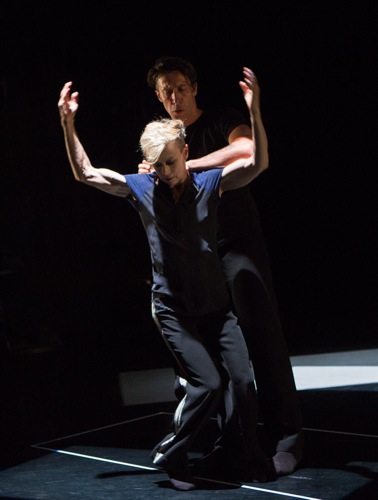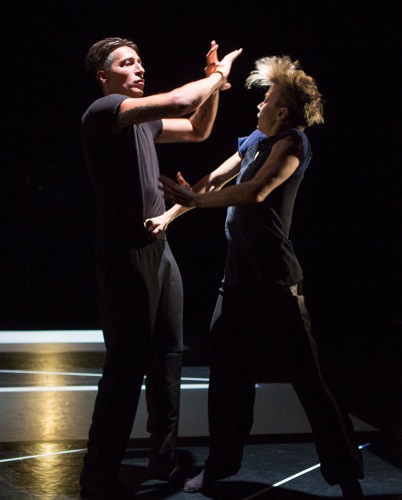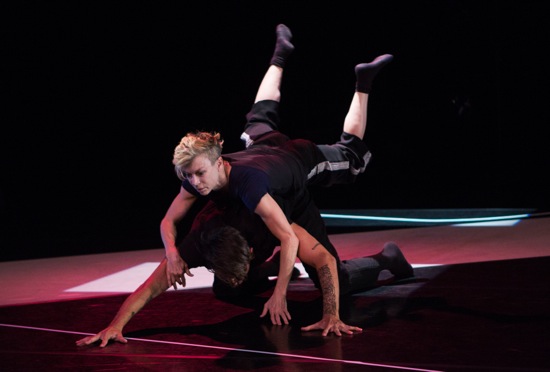Canadian dancer-choreographer Louise Lecavalier brings her “So Blue” to New York Live Arts.
I’m not sure when and where I first saw Louise Lecavalier dance with Édouard Lock and La La La Human Steps, a company she worked with from 1981 to 1999. Perhaps it was during the late 1980s at the biennial Festival International de Nouvelle Danse in Montréal (1985-2003). I also saw her at Dance Theater Workshop in New York. I am sure however, of the lasting impression she made. Small, lean, and muscular, her mop of white blond hair flying, she could take off, spin almost horizontally in the air, and land like a log in the arms of a waiting partner or partners. She could pick up a guy twice her size; she could dive to the floor and recover in a split second. Add to that a glamorous face and a strong background in ballet, and, voilà, a star who ate ordeal for breakfast. (For a glimpse of her in Lock’s 1985 Human Sex, click on this: https://www.youtube.com/watch?v=l2ORZCdazM0.)
Now Dance Theater Workshop has another building and another name (New York Live Arts), and Lecavalier has become a choreographer. Shown at NYLA, her first independent work, So Blue (2012), created and performed with Frédéric Tavernini, reveals both what the years have changed and what remains the same. Lecavalier is approaching her fifty-seventh birthday; some years ago, she had major surgery on one hip; she is the mother of twin girls who turn thirteen this year. She doesn’t fling her legs in the air a lot, although once in So Blue, she lifts one leg high and holds it there while she hops across the stage. Nor does she bare as much of her muscular body as she used to (costume by Yso). Yet when she maintains a headstand, her shirt slips down to reveal her sculpted torso expanding and contracting with each breath. She has a man’s haircut, topped with a big free-flying swatch of longer hair.
Alone during this first part of So Blue, she dances as if a desire for speed were constantly goading her on. As if to stop might be dangerous. The landscape she traverses is an ingenious display of patterned light by Alain Lortie. White lines and rectangles laid horizontally, diagonally, or from front to back, create a gray-and-white design against a black floor. So Lecavalier has paths and way stations she’s free to use or ignore. Montreal-based musician Mercan Dede provides a vivid, changeable landscape of electronic, digital, and human sounds (additional music by Normand-Pierre Bilodeau, Daft Punk, and Meiko Kaji).
High-toned percussion, whistles, and thuds accompany Lecavalier as So Blue begins, and she starts moving sideways across the stage with rapid, criss-crossing steps—almost stumbling, as if blown by a strong wind. She hits defensive crouches, then straightens up and minces along on neat tiptoe. She works her hips. What she has affirmed—and what you can see in the long first solo that precedes a shorter duet with Tavernini—is that her gestures and motions are derived from everyday movements and poses. That doesn’t mean that you always recognize them as such; she may truncate certain ones and repeat them over and over, or pass through them so speedily they’re gone before you can latch onto them.
You get the feeling of a woman trying this and trying that, never sure which move will get her what she wants, but she either has no sure goal or doesn’t have time to wait for an outcome. Lecavalier’s speed and energy rarely flag. At one point, she goes to one side of the area, turns on a standing fan, and lets it blow on her while she swigs some water and changes her shirt. Then it’s back to the ordeal.
Reality gets a makeover. When she flutters her hands in the air around her head, you imagine a mosquito attack but it’s been transformed into a seconds-long dance motif. When she lies prone and repeatedly pushes her butt up, you imagine a move that presages getting up off the floor being repeated—tinkered with—for its own sake. Her mouth moves in silent talk, her fingers point, her hands shake, her fists punch air. And all the while, her feet are jittering in place or carrying her here and there— rushing, skittering, ducking, collapsing.
When Tavernini, enters, he proves to be as fluent and fast as she is. Sharing the stage, but not yet touching, the two show that they can both move with a complex, slippery, nervous facility— ribcage, hips, scudding feet, and busy arms all working at once.
On the other hand, Tavernini brings a very different presence to the stage. He’s tall and laconic, almost morose. At times, you get the impression that Lecavalier is a machine gone wild, and he doesn’t know how to turn her off. But small as she is, she’s almost as strong as he. He nudges her along, drags her around; she rides him; he crawls bearing her on his back. There’s no hostility in this, no competitiveness. The actions that convey conflict also convey support. This is how their day goes. I do this, you do that, you help me, we manage this together.
I confess to drifting off at time during Lecavalier’s lengthy solo, numbed by its almost remorseless intensity. And yet her prowess, her ingenuity, and her drive to keep going also have a gallantry that’s very moving. We know what that’s like; we should be so strong. In 2015 alone, Lecavalier has performed/will perform So Blue about twenty-three times in Canada, France, the U.S., and Taiwan. She racked up a little more than that between 2012 and the end of 2014. She’s booked into 2016.
Like a glimpse of So Blue? Click here: https://www.youtube.com/watch?v=F516qFx7zdw.




Deborah, DTW first brought Louise to New York with Edouard Lock’s La La La Human Steps in Business in the Process of Becoming an Angel and then again in Human Sex. Louise’s duet’s with Marc Bedard were explosive, pushing back the walls, and worthy of an early Bessie.recognition. No one had ever seen performances like theirs.
BTW, on another subject, what do you think of the complete absence of any acknowledgment of the 50th anniversary of the founding of DTW. One should probably expect the erasure of DTW’s history by NYLA, but what happened to the press, what happened to DTW’s alumni? The irritatingly endless celebration of Judson and its offspring is only one tale of contemporary dance’s development.
For some reason, I didn’t receive a print copy of NYLA’s season brochure and only just thought to access it online. Now I understand your anger, David. Here’s the offending sentence that opens the brochure: “Welcome to our fifth season of New York Live Arts, an institution created from 50 years of combined history.” It doesn’t even fully make sense. Combined with what? I imagine an editorial finger eliminating the name of Dance Theater Workshop without thinking of the effect on the sentence’s meaning. Might it not instead have said “. . .50 years of combined history with Dance Theater Workshop, whose organization NYLA took over and built on?” Or even just “. . .50 years of combined history with Dance Theater Workshop?”